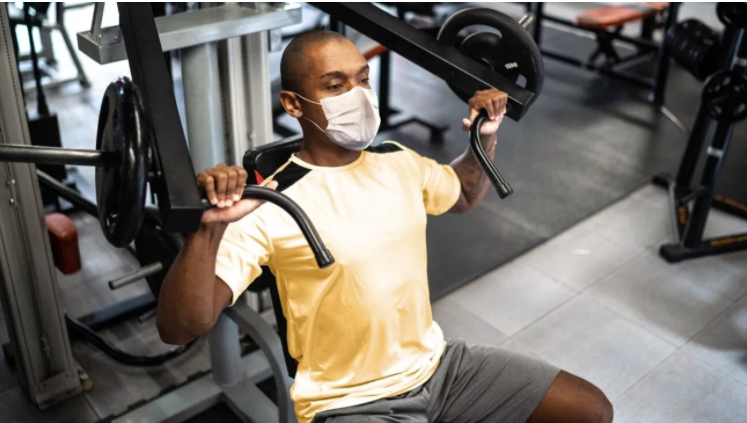
Studies indicate that cloth masks and surgical masks don’t seem to hinder exercise performance, even during intense workouts. FG Trade/Getty Images

Studies indicate that cloth masks and surgical masks don’t seem to hinder exercise performance, even during intense workouts. FG Trade/Getty Images
All data and statistics are based on publicly available data at the time of publication. Some information may be out of date. Visit our coronavirus hub and follow our live updates page for the most recent information on the COVID-19 pandemic.
According to the Centers for Disease Control and Prevention (CDC)Trusted Source, the new coronavirus, SARS-CoV-2, that causes COVID-19 is mainly transmitted by respiratory droplets.
The best way to control these droplets, the CDC says, is to wear a face covering, like a cloth mask.
Face masks have been somewhat controversial in the United States, however, with many expressing concerns about whether they can inhibit breathing.
In particular, people have raised questions about whether masks might cause any safety or performance issues during exercise.
But a new study in the International Journal of Environmental Research and Public Health has found that mask-wearing appears to have virtually no detrimental effects during vigorous exercise.
In their study, the researchers evaluated both surgical masks and cloth masks since those are commonly available to the general public. These were compared to wearing no mask at all.
Fourteen young, healthy adults (seven men and seven women) took part in the study.
Each study participant completed a cycle ergometry test (riding a stationary bike) to exhaustion while wearing either a surgical mask, cloth mask, or no mask.
Researchers randomly determined in what sequence participants would test each mask.
During testing, participants’ blood oxygen levels were measured via pulse oximetry.
Their tissue oxygenation index was also measured using a tool called near-infrared spectroscopy in their vastus lateralis, a muscle in the thigh.
When the researchers examined the data from this testing, they found that wearing face masks had no effect on performance (time to exhaustion) or peak power.
There were also no differences found when it came to blood oxygen levels, tissue oxygenation index, perceived physical exertion, or heart rate.
Nor was there any detectable negative effect on blood or muscle oxygenation or exercise performance.
Shanina Knighton, Ph.D., RN, CIC, an infection preventionist and KL2 scholar at Case Western Reserve University, said this study “tells us that exercise performance is not impacted by wearing a face mask.”
She added that this study is consistent with other studies that have been done on this topic.
She further explained, however, that while it may tell us about how mask-wearing affects athletic performance, it “cannot and should not take away from the lived experience of the individual.”
“There is limited evidence to support issues for people with asthma or breathing issues. However, it is important to note that many people with acute and chronic respiratory conditions also have anxiety or panic attacks,” Knighton said.
“Sometimes the anxiety of feeling restricted from breathing from the masks propagates the trigger or perception of breathing issues,” she said.
Knighton also noted that many studies suggest that people with respiratory conditions should seek further evaluation before wearing a mask or exercising.
According to Jenna Moore, MS, CSCS, an assistant director of fitness wellness at Binghamton University, there are three main factors that you will need to consider when it comes to wearing a face-covering during exercise: the type of exercise (cardio versus strength training), the intensity of the exercise (low versus high), and the type of face-covering you’ll be wearing.
Moore said that cardio exercises like running and cycling will be more affected by mask-wearing.
“While face coverings don’t significantly affect oxygen intake, it does affect many individual’s ability to breathe comfortably,” Moore said.
She said people doing this type of exercise will likely need to lower their intensity at first and take longer recovery breaks.
“However, after a few weeks of wearing a face-covering during this type of activity, individuals will acclimate and be able to work at, or near, their usual intensity levels with little to no impact on performance,” Moore said.
She added that people performing high-intensity exercise, such as high-intensity interval training (HIIT), are the main ones who will be affected.
If you’re doing lower-intensity exercise, such as basic weight training or going for a leisurely walk, you may not feel the same effects from wearing a mask, she said.
Moore cautioned, however, that if you begin to feel lightheaded or dizzy, you should stop exercising immediately and go somewhere away from other people so you can remove your face covering and catch your breath.
Moore said that disposable, three-ply face masks are recommended for exercise. They’re more breathable and don’t tend to become saturated with sweat and respiratory droplets the same way that cloth masks do.
Moore noted that more and more athletic companies are coming out with face masks geared toward athletic performance, but you may need to test out a few types until you find the best one for you.
She said you may also want to bring a few extra masks with you so you can change them out if your mask becomes saturated with moisture.
Finally, Moore said, make sure that any face covering you’re wearing covers your nose and mouth. This will do the best job in capturing respiratory droplets.
Authored By:
Nancy Schimelpfening on November 11, 2020 — Fact checked by Dana K. Cassell. Originally published on the Healthline Blog